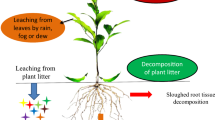Summary
The incidence and severity of Rhynchosporium secalis infections were assessed in a large population of Hordeum leporinum. Transects were set out in four directions from five trees to determine the effect of shading. Under the tree canopy 60.3% of H. leporinum plants were infected while only 11.2% were infected away from the canopy. Disease severity, on those plants which were infected, was higher under the canopy (mean 12.4% and 13.0% leaf area diseased for the flag and first leaves, respectively) than away from the canopy (means of 7.8% and 5.0% for the flag and first leaves respectively). Plants under the tree canopy contained on average 23% more nitrogen, raising the possibility that the susceptibility of the host changed in response to nitrogen levels. However, the observed pattern is also consistent with the hypothesis that shade-associated changes in the environment enhanced the ability of the pathogen to infect and develop on the host. The data clearly demonstrate the importance of small-scale environmental factors on natural host-pathogen interactions. These environmental factors may cause differential selection for disease resistance within a host population, which may ultimately lead to the formation of sub-populations with differing levels of resistance.
Similar content being viewed by others
References
Augspurger CK (1984) Seedling survival of tropical tree species: Interactions of dispersal distance, light-gaps, and pathogens. Ecology 65:1705–1712
Augspurger CK, Kelly CK (1984) Pathogen mortality of tropical tree seedlings: Experimental studies of the effects of dispersal distance, seedling density, and light conditions. Oecologia (Berlin) 61:211–217
Burdon JJ (1987) Disease and Plant Population Biology. Cambridge University Press, Cambridge
Burdon JJ, Müller WJ (1987) Measuring the cost of resistance to Puccinia coronata Cda in Avena fatua L. J Appl Ecol 24:191–200
Burdon JJ, Marshall DR, Brown AHD (1983) Demographic and genetic changes in populations of Echium plantagineum. J Ecol 71:667–679
Caldwell RM (1937) Rhynchosporium scald of, barley, rye, and other grasses. J Agric Res (Washington DC) 55:175–198
Dinoor A, Eshed N (1984) The role and importance of pathogens in natural plant communities. Ann Rev Phytopathology 22:443–466
Jarosz AM (1984) Ecological and evolutionary dynamics of Phlox-Erysiphe cichoracearum interactions. Ph.D. thesis, Purdue University
Jarosz AM, Levy M (1988) Effects of habitat and population structure on powdery mildew epidemics in experimental Phlox populations. Phytopathology (in press)
Jenkins JEE, Jemmett JL (1967) Barley leaf blotch. NAAS Q Rev No 75: 127–132
Lukens RJ, Mullany R (1972) The influence of shade and wet soil on southern corn leaf blight. Plant Dis Rept 56:203–206
Nevo E, Moseman JG, Beiles A, Zohary D (1984) Correlations of ecological factors and allozyme variations with resistance to Erysiphe graminis hordei in Hordeum spontaneum in Israel: Patterns and Applications. Plant Syst Evol 145:79–96
Nevo E, Moseman JG, Beiles A, Zohary D (1985) Patterns of resistance of Israeli wild emmer wheat to pathogens I. Predictive method by ecology and allozyme genotypes for powdery mildew and leaf rust. Genetica 67:209–222
Nevo E, Gerechter-Amitai Z, Beiles A, Golenberg EM (1986) Resistance of wild wheat to stripe rust: Predictive method by ecology and allozyme genotypes. Plant Syst Ecol 153:13–30
Ozoe S (1956) Studies on the Rhynchosporium scald of barley and its control. Shimane Prefectural Agric Inst Bull 1:1–122
Schnathorst WC (1965) Environmental relationships in the powdery mildews. Ann Rev Phytopathology 3:343–366
Shipton WA, Boyd W, Ali SM (1974) Scald of barley. Rev Plant Pathology 53:839–861
Snaydon RW, Davies MS (1972) Rapid population differentiation in a mosaic environment. II. Morphological variation in Anthoxanthum odoratum Evolution 26:390–405
Twine JR Williams CH (1971) The determination of phosphorus in Kjeldahl digests of plant material by automatic analysis. Comm Soil Sci Plant Anal 2:485–489
Author information
Authors and Affiliations
Rights and permissions
About this article
Cite this article
Jarosz, A.M., Burdon, J.J. The effect of small-scale environmental changes on disease incidence and severity in a natural plant-pathogen interaction. Oecologia 75, 278–281 (1988). https://doi.org/10.1007/BF00378609
Received:
Issue Date:
DOI: https://doi.org/10.1007/BF00378609




